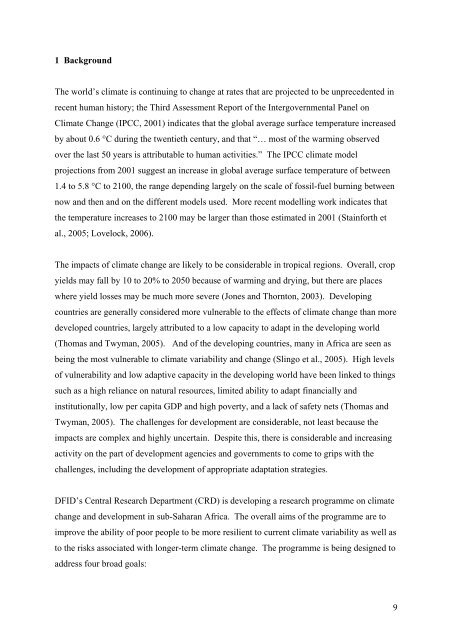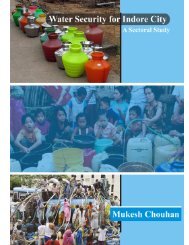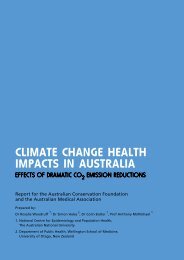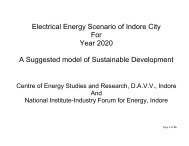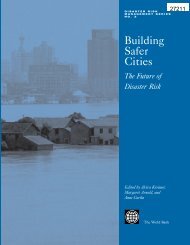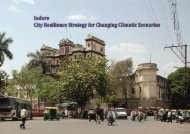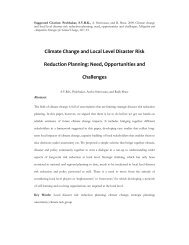Mapping climate vulnerability and poverty in Africa - CGSpace Home
Mapping climate vulnerability and poverty in Africa - CGSpace Home
Mapping climate vulnerability and poverty in Africa - CGSpace Home
You also want an ePaper? Increase the reach of your titles
YUMPU automatically turns print PDFs into web optimized ePapers that Google loves.
1 Background<br />
The world’s <strong>climate</strong> is cont<strong>in</strong>u<strong>in</strong>g to change at rates that are projected to be unprecedented <strong>in</strong><br />
recent human history; the Third Assessment Report of the Intergovernmental Panel on<br />
Climate Change (IPCC, 2001) <strong>in</strong>dicates that the global average surface temperature <strong>in</strong>creased<br />
by about 0.6 °C dur<strong>in</strong>g the twentieth century, <strong>and</strong> that “… most of the warm<strong>in</strong>g observed<br />
over the last 50 years is attributable to human activities.” The IPCC <strong>climate</strong> model<br />
projections from 2001 suggest an <strong>in</strong>crease <strong>in</strong> global average surface temperature of between<br />
1.4 to 5.8 °C to 2100, the range depend<strong>in</strong>g largely on the scale of fossil-fuel burn<strong>in</strong>g between<br />
now <strong>and</strong> then <strong>and</strong> on the different models used. More recent modell<strong>in</strong>g work <strong>in</strong>dicates that<br />
the temperature <strong>in</strong>creases to 2100 may be larger than those estimated <strong>in</strong> 2001 (Sta<strong>in</strong>forth et<br />
al., 2005; Lovelock, 2006).<br />
The impacts of <strong>climate</strong> change are likely to be considerable <strong>in</strong> tropical regions. Overall, crop<br />
yields may fall by 10 to 20% to 2050 because of warm<strong>in</strong>g <strong>and</strong> dry<strong>in</strong>g, but there are places<br />
where yield losses may be much more severe (Jones <strong>and</strong> Thornton, 2003). Develop<strong>in</strong>g<br />
countries are generally considered more vulnerable to the effects of <strong>climate</strong> change than more<br />
developed countries, largely attributed to a low capacity to adapt <strong>in</strong> the develop<strong>in</strong>g world<br />
(Thomas <strong>and</strong> Twyman, 2005). And of the develop<strong>in</strong>g countries, many <strong>in</strong> <strong>Africa</strong> are seen as<br />
be<strong>in</strong>g the most vulnerable to <strong>climate</strong> variability <strong>and</strong> change (Sl<strong>in</strong>go et al., 2005). High levels<br />
of <strong>vulnerability</strong> <strong>and</strong> low adaptive capacity <strong>in</strong> the develop<strong>in</strong>g world have been l<strong>in</strong>ked to th<strong>in</strong>gs<br />
such as a high reliance on natural resources, limited ability to adapt f<strong>in</strong>ancially <strong>and</strong><br />
<strong>in</strong>stitutionally, low per capita GDP <strong>and</strong> high <strong>poverty</strong>, <strong>and</strong> a lack of safety nets (Thomas <strong>and</strong><br />
Twyman, 2005). The challenges for development are considerable, not least because the<br />
impacts are complex <strong>and</strong> highly uncerta<strong>in</strong>. Despite this, there is considerable <strong>and</strong> <strong>in</strong>creas<strong>in</strong>g<br />
activity on the part of development agencies <strong>and</strong> governments to come to grips with the<br />
challenges, <strong>in</strong>clud<strong>in</strong>g the development of appropriate adaptation strategies.<br />
DFID’s Central Research Department (CRD) is develop<strong>in</strong>g a research programme on <strong>climate</strong><br />
change <strong>and</strong> development <strong>in</strong> sub-Saharan <strong>Africa</strong>. The overall aims of the programme are to<br />
improve the ability of poor people to be more resilient to current <strong>climate</strong> variability as well as<br />
to the risks associated with longer-term <strong>climate</strong> change. The programme is be<strong>in</strong>g designed to<br />
address four broad goals:<br />
9


